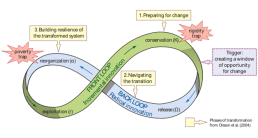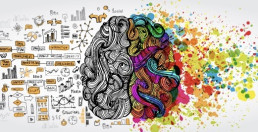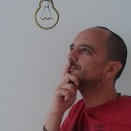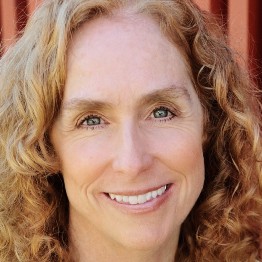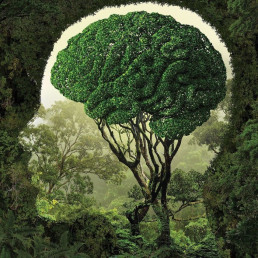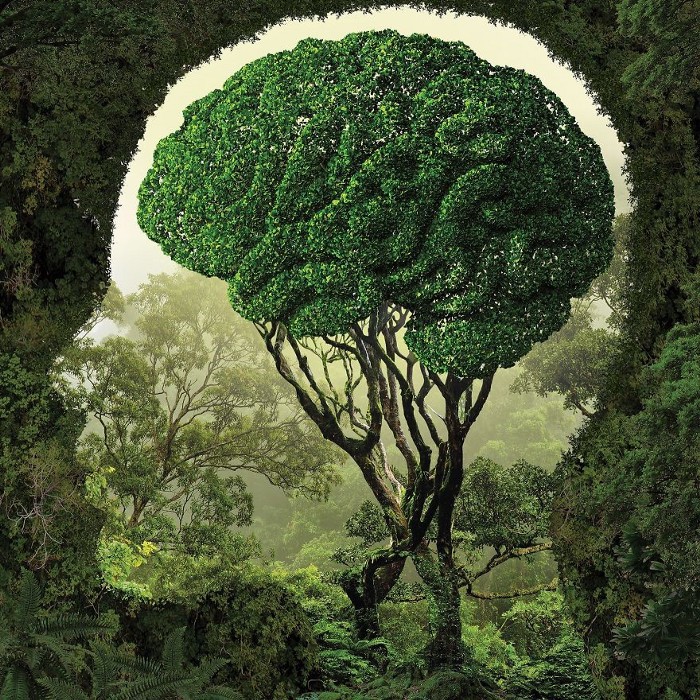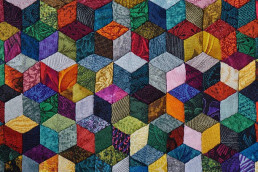Power of Networks: Interconnectedness Drives Change
Our world is beset by societal challenges that are large, complex, dynamic and highly contextual. Networks can play a transformative role in resolving these challenges by sparking an interconnected web of actors and actions. Catalysing networks is key to enabling a sustainable ecosystem with diverse actors who have the capability to sense, synthesise and respond to societal problems by varied means – both normative and descriptive.
Networks are about relationships and interactions between actors in a system. Interactions can be of any type (e.g., consumes data, creates content, conducts workshops, etc.) which allow us to harness natural community responses and bridge the distance between those who need and actors who can.
In this 90 minutes webinar, Sanjay Purohit, Chief Curator – Societal Platform at EkStep Foundation, discussed the Power of Networks and covered:
- The importance of network effects and the view of a network as units of interactions – moving from 1:many interactions to many:many.
- The need to facilitate interactions between and within formal and informal networks, involving state, civil society and markets, to catalyse large-scale systemic change.
- How can digital platforms amplify the impact of these interactions and enable societal change at scale?
Sanjay Purohit, Chief Curator - Societal Platform, EkStep Foundation talks about the Power of Networks.
Originally published at Societal Platform
co-creating pathways for a resilient society
Societal Platform is a community of curators, catalysts, and network weavers. We pool our individual strengths and channel our collective imagination to enable social change leaders to advance their missions.
PLEASE DONATE to help Network Weaver continue in it’s mission to offer free support and resources to networks worldwide.
Patterns of Collective Flight
This article is dedicated to my fellow super-connectors, movement weavers, story activators, and of course, visionary poets and meta-pattern identifiers — all of whom are seeking to create a more just and equitable world. They include: those who design new economies and value exchanges through open innovation and knowledge sharing; those who strategically connect and relation-build; those with balanced local and planetary perspectives; and those who shape regenerative solutions.

We are like the starlings who fly in free flowing formation — though the micro story patterns continuously change, we sense the emergence of a grand unified story field as we learn to cross boundaries, take creative action and fly together in one movement.
Fight or Flight
Murmuration is a great metaphor for social change. Some of the best lessons for collaboration are found in the dynamics of living systems. Who hasn’t been mesmerized by the graceful beauty of a starling murmuration? The metaphor reveals an intuitive sensing of change, both subtle and strong, in our collective heart and mind. Our inward navigation guides us to move with others who are imagining and implementing whole-systems symmetry.
My personal flight paths are often found on the liminal edge, and many of you have graciously drawn me into your circles of flight. You’ve enticed me by your creative systems imagination and welcoming appreciation. Subtly and fluidly, our flight paths flow together to harmonize in story patterns. Our multiple perspectives converge into unified vision. If one clarifies or changes their intentions, even slightly, big shifts in collective flight patterns can change an entire systems trajectory.
Murmuration reveals a dynamic living systems dance. The starling flocks shape-shift in a swirling aerial ballet while maintaining cohesion as a group. In unison, they conduct evasive maneuvers in uncertain environments often sparked by the presence of a predator species.
This dance is achieved by interacting with six or seven of one’s closest neighbors, optimizing the balance between group cohesion and individual effort. If one bird affects its seven closest neighbors, then each of those neighbors’ movements affect their closest seven neighbors through the flock. This is how a swarm becomes an intelligent cloud traveling in many directions, at various velocities.
Murmurations optimize a form of agility, neural transmissions or signals of shared information which elegantly transcend our rigid organizational diagrams attempting to define self-organization. Like passages of time and music, we resonate at deep levels of universal beauty and symmetry, understanding in ways that transcend explanation.
The science of synchronization
But for those who prefer scientific analysis, Jaymi Heimbuch talks about the science of synchronization at Mother Nature Network, “the secret lies in the same systems that apply to anything on the cusp of a shift, like snow before an avalanche, where the velocity of one bird affects the velocity of the rest.” This is known as “scale-free correlation,” and every shift of the murmuration is called a critical transition. Giorgio Parisi, a theoretical physicist at the University of Rome, lead a research team looking into the amazing movement of starlings and published a paper in the Proceedings of the National Academy of Sciences in 2010:
“The change in the behavioral state of one animal affects and is affected by that of all other animals in the group, no matter how large the group is. Scale-free correlations provide each animal with an effective perception range much larger than the direct inter-individual interaction range, thus enhancing global response to perturbations.”
Jaymi points out,“Because the size of the flock doesn’t matter, a huge flock is able to respond to a predator attack as effectively and fluidly as a small flock. No matter the size, the system works. If one bird changes speed or direction, so do the others. The question remains, however, how does an individual bird spark a change if all are busy responding to the movement of everyone else? And more importantly, how do they do it so incredibly quickly?”
And for systems geeks
Murmurations are a compelling visual representation of “complex adaptive systems.” They self-organize a spontaneous emergence of new patterns, causing adaptive reorganization. The shapes or outcomes cannot be determined since they are not designed from the “outside” (as are most human systems), but are adaptive to the flock itself.
According to systems scientists, because of their ability to process and create information, complex adaptive systems can change their behavior, co-evolve and adjust to new rules that govern relationships with their surrounding environment. These systems are sensitive enough to undergo rapid and unpredictable transformations while they seek to maintain stability and balance in the midst of internal and external fluctuations.
Murmurations also represent systems known as “edge of chaos systems” which are full of creative novelty and experimentation. These systems react to small changes in unexpected ways, communicate instantaneously, and gracefully maneuver unpredictable shifts in direction when responding to predators or roadblocks.
According to John Cleveland’s Complexity Theory — Basic Concepts and Application to Systems Thinking, “A vibrant democracy is an ‘edge of chaos’ form of governance; a healthy market is an ‘edge of chaos’ form of economics; a flexible and adaptive organization is an ‘edge of chaos’ institution; and a mature, well-developed personality is an ‘edge of chaos’ psyche.” He goes on to explain that many systems involve a closed or rigid order which make them incapable of adaptable systems evolution.
Indeed, complex adaptable systems, like nature’s systems, are abstract and thrive in perpetual motion. To some, these systems pose a threat and need to be controlled, harnessed or exploited. History is rife with tension between hierarchical social control (think mechanistic technologies, monopolies, dictatorships) and decentralized, “edge of chaos” systems.
But the great equalizing force between seemingly incoherent chaos and rigid order ideally meets somewhere in the middle on common ground. This is the sweet spot, where new regenerative systems have the opportunity to tap into the creative force of edge chaos (artists thrive in edge chaos systems btw), causing adaptive systems to grow, learn and evolve.
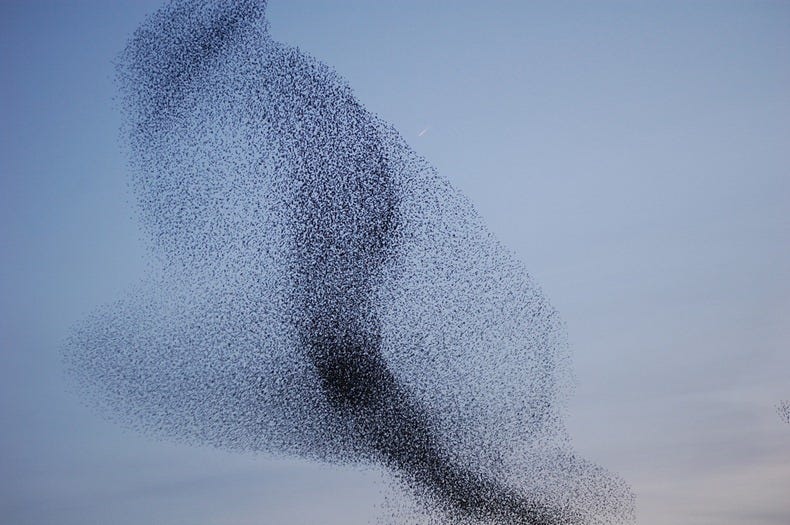
The open knowledge and story platforms set a table — a feast for resource exchange, cooperation, dreaming and making meaning. The collective flight allows for fluid moving between disciplines, sectors, siloed thinking. We become part of a dynamic “murmurating system” that leverages uncertainty while maintaining a form of consensus; a sublime coordination that consistently transitions from scattered chaos to identifiable patterns. And as we seek to learn and make meaningful connections outside of our immediate flocks, the entire pattern shifts.
Synchronization is poetry, poetry is art. Art has always been a more productive use of energy than the “fight”. The cool news is that living systems cannot be controlled by hierarchies or individual parts. Living systems are adaptable whole-systems that seek symmetry, beauty and balance.
As each of us becomes more adept at processing information that is attuned to deeper universal patterns, we can adapt by intuitively navigating complex system realities. We can not only adapt but fly, riding the air currents to higher heights while weaving new story patterns and harmonizing our aligned efforts.
Originally published at Medium.com
Thea La Grou is a visual communicator who occasionally uses words — a “creative entrepreneur,” artist, media alchemist and producer collaborating with cultural creatives, systems architects, and networked movements. She is Co-founder and Marketing Director at Millennia Music & Media, FPC, Founder and Executive Director at Compathos Foundation and is an Edmund Hillary Fellow. Author, speaker, and event producer — Thea specializes in crafting experiences that harness the shifting nuances of storytelling and bring people together to find meaningful action around the common good. Her latest ventures include TwelfthMuse, IMERSIVstorylab, and Films for the Planet— the best in environmental and social action films on demand.
________________________________________
PLEASE DONATE to help Network Weaver continue in it’s mission to offer free support and resources to networks worldwide.
From Nature’s Mutualistic Networks to More Resilient Human Networks
We have been taught to live in a competitive, survival-of-the-fittest world. But what if this has been wrong? What if the natural world, and the humans in it, are much more cooperative than competitive?
The idea of the survival of the fittest originated in Darwin’s Origin of Species, and his theory of natural selection. Sure, natural selection does have a role to play in evolution, but it might not be as important as we had previously thought. In fact, some scientists assign it a weight of just 1 out of 10 concerning the evolution of certain processes, such as the evolution of the anatomy of species[i]. Other scientists suggest that evolution should not be considered in terms of species as separate from its environment, but at the level of the system itself (species + environment). Looking at it from this perspective, they maintain, is much simpler and governed by a much smaller set of laws, than analyzing the evolution of elements by themselves[ii].
We can find examples of mutualism and cooperation all over the natural world, from pollinators and plants, to animals and the microbes living in their guts. And in many cases this cooperation is not merely optional, but essential to life itself. Certain plants will not grow in soils where you cannot find a specific type of fungi, since they need to form a relationship with it in order to survive. Lichens are an association between a bacterium and a fungus. They are an organism that is an association of two different life forms, contradictory as the notion may seem. Trees communicate with each other through a network of mycorrhizae, a fungal structure invisible to the naked eye that connects their roots, transporting nourishment, messages and even teachings (yes, plants have cultural transmission and are able to learn from their neighbors)[iii].
And the human species is no exception. We have more bacteria living in our gut than we have cells in our bodies, and they influence our health, our moods and even our behaviors[iv]. Without them, we cannot survive. (Not to mention the fungi that live basically everywhere and the microscopic mites on our skin.) We are not just a single organism; we are a small cosmos of organisms. And like all other species, we are not meant to just compete, but to cooperate harmoniously with those around us.
What is conspicuous about cooperative interactions in the natural world is that they happen in networks. This a very familiar word in the human lexicon, since we network for just about anything: for business, for trade, for information exchange. What can we learn from these well-functioning natural cooperative networks that we can apply to our human ones, so that they are more resilient?
First of all, if we take a look at mycorrhizal networks in old-growth fir forests[v], we find that young saplings are established within the networks of veteran trees. Usually, the larger the trees (and the more resources they have), the more well-connected they are within the forest network. This highlights the importance of large mature trees in the architecture of the network, which have long life-histories of connection. Greater establishment of young saplings have also been shown when they are linked into the mycorrhizal network of larger trees. The lessons to learn from this are quite simple: if you have more resources, share them, and you will help others flourish. Also, we need multigenerational human networks: elders have a lot of wisdom to impart, and if youngsters are connected to them to “absorb” it, they are more likely to thrive.
The forest networks also have what we call small-world properties, meaning that individuals are closely knit together, and that you do not have to go through many to get from any one individual to another. Simple enough as well, right? Do not isolate yourself, if you connect and collaborate with others, you are also more likely to thrive in your community.
Forest network symbiosis is not just an affair between two or more organisms, but a complex assemblage of fungal and plant individuals that spans multiple generations. In them, fungus species form “living links” connecting trees and allowing them to communicate and exchange resources, and benefitting from the exchange as well. In our networks, human connections do not have to be strictly restricted to flows of information or products, they can be other people (facilitators, teachers, networkers), living links that enable effective exchange of any kind between other people or groups.

Last but not least, these networks are robust to perturbations, but fragile to the targeted removal of the “hubs”, large mature trees. If elders are left out or removed from contributing, the whole ecosystem is more likely to collapse.
So far, we have been looking at relatively simple networks, connecting individuals of a few species only, and belonging to the same forest “group”. Now let’s take it a step further and take a look at networks that involve far larger numbers of species interacting. And at the same time make an analogy with different “species” of organizations trying to cooperate.
There are several types of networks in nature, and they are of two main types: antagonistic (e.g: food webs, parasitism) and mutualistic (e.g: pollination, seed dispersal). A study by Thébault and Fontaine[vi]analyzed several characteristics of both types of networks, focusing on pollination (mutualism) and food webs (antagonism), to find out what made them more persistent and resilient. They found out that the two types of networks behaved quite differently.
While antagonistic networks benefit from being modular (having subgroups that interact heavily amongst themselves and very little with other groups – does that sound familiar?), the cooperative mutualistic networks that we are interested in were strengthened by a nested structure. This means that there are a lot of “specialists” in the network, interacting with subsets of the group that “generalists” interact with. At an organizational level, “generalists” are larger organizations that have several areas and a wide range of action, such as groups focusing on governance and policy, and can interact with many other smaller, grassroots “specialists” focusing on one or two areas of action. How do we ensure the nested structure in a human network? We make sure that there are no local groups that are isolated from the world at large and from larger spheres of power. The smaller grassroots organizations and groups can (and should!) cooperate with each other at a local level, but not without being connected to larger organizations that ensure that they have a voice at a regional, national or global level.

Another study[viii] provides even more lessons to be learned from nestedness: it not only helps to reduce competition and increase the number of coexisting species, but a nested structure like this is likely to arise by itself, as long as new species enter the community at the places where they have the least competitive load. When a new group wants to cooperate, welcome it in the place where it is most needed, where the skills and value it provides are most lacking, and take the best advantage of the complementarity!
Mutualistic networks tend to have one other characteristic in common, which is related to nestedness: they are asymmetric. There are a few “generalists” and a whole lot of “specialists”[ix]. The generalists interact with each other, but also with the specialists. A lot of grassroots activity is good: but so is getting the word out there about your work and spreading local solutions to the global level—”Think Global, Act Local”.
The final two things that increase persistence and resilience of networks are two very simple ones: high diversity and high connectance. Diversity is self-explanatory, and quite obvious. High connectance means that a high percentage of the possible links are materialized, so also at this level, connect and collaborate as much as you can (within reason), and the benefit for all will be increased.
And here is a bonus lesson: a study by Evans et al.[x] that analyzed the interconnectivity of networks on a British farm reached a very interesting conclusion. Two habitats that were not very representative in terms of area were disproportionately important. This gives us a clue that there may be groups out there with skills and areas of action that still tend to be overlooked at the grassroots and even the governance level (tipping my hat to the ethical technology and governance folks), but whose work others will rely immensely upon to be able to keep the integrity of the network.
But this is not the end of it: stay tuned for the multilayer nature of ecological networks and how to apply its lessons to community organizing!
[i] Lewin, Roger (1993) Complexity: Life at the Edge of Chaos. Phoenix, Orion Books, London
[ii] Lotka, Alfred (1925) The Elements of Physical Biology. Williams and Wilkins, Baltimore
[iii] Simmard, S. W. (2018) Mycorrhizal Networks Facilitate Tree Communication, Learning, and Memory. In: Memory and Learning in Plants. Springer International Publishing, AG
[iv] Gilbert, S. F., Sapp, J. & Tauber, A. I. (2012). A Symbiotic View Of Life: We Have Never Been Individuals. Quarterly Review Of Biology 87(4): 325-341
[v] Beiler, K. J. et al. (2010) Architecture of the wood-wide web: Rhizopogon spp. genets link multiple Douglas-fir cohorts. New Phytologist 185: 543–553
[vi] Thébault, E. & Fontaine, C. (2010) Stability of Ecological Communities and the Architecture of Mutualistic and Trophic Networks. Science 329: 853-856
[vii] Palazzi, M. J. et al. (2019) Online division of labour: emergent structures in Open Source Software. Scientific Reports 9(1): 1-11
[viii] Bastolla, U. et al. (2009) The architecture of mutualistic networks minimizes competition and increases biodiversity. Nature 458: 1018-1020
[ix] Bacompte, J. & Jordano, P. (2007) Plant-Animal Mutualistic Networks: The Architecture of Biodiversity. Annu. Rev. Ecol. Evol. Syst. 38: 567–93
[x] Evans, D. M., Pocock, M. O. J. & Memmott, J. (2013) The robustness of a network of ecological networks to habitat loss. Ecology Letters 16(7): 844-852
Originally published at Systems Change Alliance
Top Photo by veeterzy

Carolina Carvalho is a network ecologist from Portugal who researches the interconnectedness of living beings and how we might apply this knowledge to help the human species live harmoniously within the web of life.
PLEASE DONATE to help Network Weaver continue in it’s mission to offer free support and resources to networks worldwide.
“Lean Weaving”: Creating Networks for a Future of Resilience and Regeneration
I’m fInishing up David Fleming’s book Surviving the Future, and buzzing with ideas and questions about the role of networks, network weaving and energy network science in these times of “systemic release” (see the adaptive cycle below, and more about the cycle here).
Fleming’s book, a curated collection of essays from the heftier Lean Logic, offers some compelling thinking about the trajectory of globalized and national economies – at best de-coupling, de-growth, and regeneration, and at worst catastrophic collapse – and the ways in which intentional and more localized culture building and reclamation as well as capacity conservation, development and management, might steer communities to healthier and more whole places post-market economy.
One of my favorite quotes from Fleming is that large-scale problems do not require large scale solutions; they require small-scale solutions within a large scale framework. That resonated immediately, even if I didn’t know exactly what he meant when I first read it. Re-reading more carefully, I hear Fleming making the argument that to take on systemic breakdown at scale is a fool’s errand – too massive, too slow, too much rigidity to deal with, too much potential conflict, too abstracted from real places and people.
Instead what is required is more nimble small-scale solutions happening iteratively and quickly (relative to how slow things move at larger levels). This suggests that action for resilience must happen at more local and regional levels, connecting diverse players in place, helping to encourage more robust exchanges of all kinds (including multiple “currencies”) and culture building. David Fleming offers the following definition of the lean economy (as opposed to the taut perpetual growth economy): “an economy held together by richly-developed social capital and culture, and organized around the rediscovery of community.” How might we weave that fabric even as others unravel?
Lean (network) weaving (a new term?) would focus on helping to create more intricate, high quality/high trust and diverse connections as well as facilitating robust, nourishing flows in tighter and more grounded cycles and systems. Part of the lean weaving would entail ensuring that smaller systems remain alert, quick and flexible so as to experiment, learn and adapt. And it would also maintain connection and communication between these smaller systems/clusters (Fleming’s “larger framework”), to facilitate learning and feedback of various kinds between them (not unlike proposed bioregional learning centers).
“The more flexible the sub-systems, the longer the expected life of the system as a whole.”
David Fleming
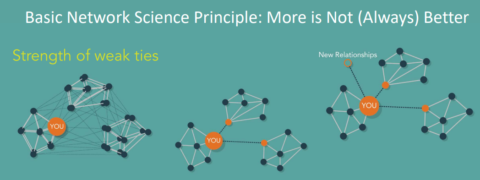
This idea of “lean weaving” also brings to mind the wisdom of network science as taught by Danielle Varda and colleagues at Visible Networks Lab. They make the point that when it comes to creating strong (resilient and regenerative) networks, more can be less in terms of the connections we have. Connectivity, like so much else in our mainstream economy and culture, can be ruled by a relentless growth imperative that is not strategic or sustainable and can cheat us of quality in favor of quantity.
More connections require more energy to manage, meaning there may ultimately be fewer substantive ties if we are spread too thin. Instead, the invitation is to think about how we mindfully maintain a certain number of manageable and enriching strong and weak ties, and think in terms of “structural holes.” For more on this network science view, visit this VNL blog post “We want to let you in on a network science secret – better networking is less networking.”
The COVID19 pandemic along with other mounting challenges may already be presenting the mandate and opportunity to get more keen and lean in our network thinking and weaving, not simply in the spirit of austerity and regression, but to cut an evolutionary path of resilience and regeneration (renewal). Network weavers of all kinds, what are you seeing and doing in this respect?
Originally published at Interaction Institute for Social Change
Curtis Ogden is a Senior Associate at the Interaction Institute for Social Change (IISC). Much of his work entails consulting with multi-stakeholder networks to strengthen and transform food, education, public health, and economic systems at local, state, regional, and national levels. He has worked with networks to launch and evolve through various stages of development.

Can problem-solving itself be problematic?
Intelligence is usually defined in terms of capacities like the ability to learn, to plan, to recognize patterns and to solve problems. So it has been hard for me – as an advocate of collective intelligence – to come to terms with the profound short-comings of problem-solving.
Problem-solving is universally respected and applied: If there’s a situation we don’t like, we believe it needs to be approached as a problem and solved. If the responsible person fails to solve it well, that’s their fault, not the fault of the problem-solving approach, itself.
In this essay I invite you to consider that problem-solving – as a way of handling troubling situations – has more pitfalls than most of us realize. In an ironic nutshell, there are some problems with problem-solving.
I find the very idea shocking. Problem-solving is so embedded in our thinking and language that it is hard to conceive of addressing challenges without trying to solve them as a problem. The problem-solving worldview is ubiquitous in our culture. I now think that that worldview generates a growing shadow for our civilization – a civilization profoundly dependent on the very problem-solving impulse that is making it increasingly vulnerable!
I’ve been considering how many of today’s “issues” and “crises” are rooted in earlier solutions. Consider, for example, what solution-based Progress looks like when we take account of its downsides:
- Better housing insulates us from “the elements”, thereby serving to alienate us from nature, dulling our instincts and capacity to respond with appropriate insight and urgency to environmental degradations unfolding around us. [ap_spacing spacing_height="5px"]
- Advanced medical care and provision of calories “solve” hunger and disease while expanding humanity’s environmental impact and frequently undermining deeper dimensions of individual, communal and environmental health. [ap_spacing spacing_height="5px"]
- Getting efficiently from A to B and acquiring our favorite products has disrupted Earth’s climate, depleted its resources, and generated massive amounts of garbage and toxicity. [ap_spacing spacing_height="5px"]
- Institutions to support people in need have generated systemic dependency and undermined traditional modes of mutual and communal caring and nurturance. [ap_spacing spacing_height="5px"]
- The efficiency of money, mass production, mass commodification and mass mobility tend to replace relational interdependence, uniqueness, meaning, reciprocity, community and artisanship. [ap_spacing spacing_height="5px"]
- Communication technologies have transplanted us from communities of place to virtual networks of like-minded people far away, decreasing local social capital needed for physical communal resilience.
People are busily working on solutions to all the solution-generated problems noted above, while the whole interconnected body of life and its support systems are coming apart. I’m not saying we shouldn’t do things “to improve people’s lives”. I’m saying it seems wise to take better account of the downsides of our current approaches because, as novelist Phillip K. Dick notes, “Reality is that which, when you stop believing in it, doesn’t go away.” What we don’t take into account usually comes back to haunt us, sooner or later.
PROBLEMS WITH LINEARITY
Most of the shortcomings of our problem-solving worldview are grounded in the fact that it is fundamentally linear and the world is fundamentally non-linear. More often than not, the bigger the situation being addressed, the more nonlinear it is and the harder it is to understand, predict and control it. We can add to that challenge the fact that our “successful” problem-solving at smaller scales (like a decision to travel by jet instead of train) is generating ever-vaster problems at larger scales, thanks to how many of us are led to prefer problematic options.
This is one example of how our problem-solving efforts take us on an A-to-B fantasy trip from identifying the problem to finding a solution that makes the problem disappear. We believe in this simple story, even when evidence suggests it is incomplete and misleading. When things go wrong, we think that we (or someone) didn’t solve the problem correctly. We don’t think that there might be some issues with problem-solving, itself. After all, we see it working so well for small, simple, mechanical (non-living) challenges like fixing a flat tire – and even for complicated challenges like sending someone to the moon. (See my writeup of the Cynefin framework.)
Unfortunately, the linearity of problem-solving becomes troublesome when it is applied to large, complex, nonlinear situations and systems. These are the most common types of situation faced by organizations, communities and societies today. They are extremely messy even to try solving and, more often than not, when we implement such a solution we generate “side effects” which often become problems that demand solutions of their own, ad infinitum, as suggested by the bullet list above.
Problem-solvers even have a name for the most problematic problems. They’re called “wicked problems” because they are virtually unsolvable. The more alive and complex a situation or system is, the more it features interactive moving parts, vast influential contexts, autonomous agents, and evolving demands on the solvers, themselves, to dance and transform in ways that make any “solution” temporary, at best. All this interrelational movement thwarts our efforts to nail down The Problem and arrive at a final Solution that actually makes the problem go away.
The effort to apply problem-solving approaches to messy, wicked problems tends to not only fail to work as expected, but to generate hubris and tunnel vision in us as problem-solvers. We become captivated by the heroic narrative of generating clear solutions and thus reluctant to acknowledge how such complex systemic problems tend to have many tangled causes and how our solutions almost always generate new problems. We are inclined to underappreciate, downplay, or fatally ignore the evolving web of factors that make a satisfying solution so elusive. We hang on to our linear sense of problem-solving success.
IS PROBLEM-SOLVING ACTUALLY APPROPRIATE IN THIS CASE?
If we want to use problem-solving approaches wisely, we need to recognize where they may not be appropriate, and to deeply understand why that is. It also helps to know what approaches to use instead.
I offer below a list of some characteristics of situations, conditions and systems that do not respond well to problem-solving. None of them are cognitive deal-breakers or impediments to productive engagement; there are alternative approaches that can help us work with them. For each characteristic, I’ve included examples of approaches that would probably work better than traditional problem-solving. As with so many of my lists, this one is not to be taken as comprehensive, but rather as a doorway into thinking differently about this remarkably nuanced topic.
- If we encounter significant novelty and surprises in the problem domain, we’ll need to use less problem-solving and more openness, curiosity, exploration, and creative prototyping. As we learn more, we MAY be able to shift into problem-solving mode, but always very judiciously. [ap_spacing spacing_height="5px"]
- Where the problem domain is embedded in contexts – social or natural systems, histories, assumptions, etc., that seem to be in the background but actually shape or are impacted by the problem domain – we can investigate those larger contexts and convene generative conversations among players in them before attempting problem-solving. Often, deeper understanding of the situation and relations among the players will shift the context in ways that cause the original problem to shrink or dissolve entirely. [ap_spacing spacing_height="5px"]
- Where the problem is linked to other problems – e.g., at different scales, places, times, nodes of systemic causality, etc. – we’d be wise (as above) to undertake investigations and conversations about – and among players in – those related problem domains before even thinking of solving the original problem. Unacknowledged and ignored interconnections between problem domains is a major reason why solutions in one domain create problems in other domains. Of course, the more connections we acknowledge, the more complex we realize “the problem domain” actually is, challenging us to use even less linear approaches. [ap_spacing spacing_height="5px"]
- Where we find true complexity – in other words, constant interactivity, change, evolution, and emergence happening among elements within the situation – our responses require openness, diversity, fluidity, resilience, “dancing” with change and “surfing” the waves and rapids of change rather than problem-solving. Literally “solving” something in such a situation is futile because any “target“ for our efforts is always moving and morphing, often in response to whatever we do (and even who we are). Ideally, our level of responsiveness would reflect the level of mutual responsiveness unfolding among the other elements in the system. Improvisational dance might be the best metaphor for a workable approach. We would not see ourselves as separate, fight against the interactive energies, or push a prefigured plan. [ap_spacing spacing_height="5px"]
- In response to significant but intrinsic uncertainties, it is most appropriate to respond with humility, intuition, appreciation, and exploring multiple perspectives in search of recognizable patterns rather than just trying to deny or solve the uncertainties so we can be certain enough to start problem-solving again. [ap_spacing spacing_height="5px"]
- If we’re confronted by a polarity whose elements are deeply interdependent parts of a dynamic whole – such as freedom/equality, short term/long term, individual/group, etc. – their tension cannot be “solved” in the usual sense. They need to be managed for greater synergy, short-term situational prioritization (where one or the other side of the polarity is temporarily prioritized), and a long-term balance that is dynamic, not static. [ap_spacing spacing_height="5px"]
- Predicaments – conditions that simply cannot be solved – challenge us to accept what’s going on, to minimize what harms may be associated with those conditions, to change ourselves as needed[*], and to support each other and the healthy functioning of whatever system the predicament is embedded in. In this, we may find the Serenity Prayer helpful: “God grant me the courage to change what I can change, the serenity to accept what I can’t, and the wisdom to know the difference.” [ap_spacing spacing_height="5px"]
- Finally, Mystery is always present, inviting us to learn or deepen into the implicit awe-inspiring qualities of life and existence. Such learning and deepening can go on forever. Problem-solving is often a way to skip over that dimension of our experience – but we can always shift into Mystery at any time, simply for its own sake (setting aside the whole problem-solving impulse), or to gain perspective (since certain habits or assumptions can limit our view of what’s important or possible), or to make space for more creativity to help our problem-solving become richer and wiser. This may open the door to some of the less linear approaches listed below….
ALTERNATIVE PROCESSES
Some consultants note that the effort to solve problems can lower a group’s energy – despite the fact that some analytically inclined members of the group may enjoy that mode of thinking. Various exercises – creative, physically active, etc. – can be used make group problem-solving more enjoyable.
But that can make an unhelpful activity bearable. Luckily, there are totally different approaches to deal with undesirable conditions – other than problem-solving. These include the following, which I again offer with all my earlier caveats regarding lists! [Any processes not linked herein can be found here.]
- Active or strategic appreciation. This linked essay lists some process resources for this approach as well as this challenge to our imaginations: “What would happen if we deeply understood what was going on, if we saw and were truly grateful for the positive aspects of it and, in addition, if we used that recognition to help those positive aspects and possibilities become more present and alive in the situations we were addressing?…. [Rather than] pushing what we want to change towards a predetermined outcome… [What if] we’re evoking responses from the aliveness that’s already present or trying to help that aliveness show up more fully among us. As an approach to purposeful action, it’s more aligned to the nonlinear nature of chaos and complexity than traditional problem-solving approaches.” [ap_spacing spacing_height="5px"]
- Conversation that evokes emergent shared understandings of what’s going on and what makes sense – e.g. Dynamic Facilitation and Convergent Facilitation [ap_spacing spacing_height="5px"]
- Breakout-based gatherings where multiple perspectives on and dimensions of the situation can be explored with like-minded others – e.g., Open Space Technology, Warm Data Labs, and Ephemeral Group Process [ap_spacing spacing_height="5px"]
- Creating contexts and awareness of relationship, resonance, reciprocity, and co-creativity not just with each other, but with all the elements of the situation or reality involved – e.g., Nonviolent Communication and Braiding Sweetgrass [ap_spacing spacing_height="5px"]
- Using the challenges of the situation for psychospiritual development, individually or collectively[*] – e.g., Mindfulness meditation and Bohm Dialogue [ap_spacing spacing_height="5px"]
- Using the challenges of the situation for systemic transformation – as when social change organizers help people see how the unpleasant aspects of their lives arise less from their personal inadequacies than from the dysfunctional systems in which they are embedded and which shape their lives, thereby inspiring them to act to transform those systems. See “the personal is political”
A CLOSING REALIZATION
On a break from writing this, I began to wonder to what extent problem-solving is related to our desire to predict and control, to impact the world and not have it impact us. This adds a wider lens through which to consider these “problems with problem-solving”.
More generally, I’ve been seeing more and more aspects of my work and vision falling into a spectrum between (a) order, prediction and control and (b) reciprocal learning, adaptation and relationship. Creativity and intelligence seem to be important factors at both ends of that spectrum, but (b) involves more CO-creativity and CO-intelligence.
I’ll be writing more on that soon, I suspect…..
Coheartedly,
Tom
Originally published at tomatleeblog
featured image found HERE
I'm interested in conscious evolution as an active and integrated process of personal and social transformation, as well as many subsets of that -- collective intelligence, evolutionary spirituality, wise democracy, emergent economics, etc. My main home website is http://co-intelligence.org

The Square, the Tower, and the Circle:
The Blind Spot in the Stewardship of Locally Led Systems Change Networks
The Plight of the Social Activist
Many social activists can relate to the following scenario. They sign up for an intensive training in a beautiful nearby region, with the intention of networking with fellow activists and learning about social change and innovation. The timing is perfect — they feel like they’ve been working alone for years and are struggling to see the impact of their efforts. They sense that what they’ve been doing has a significant impact on the people they touch, but at the same time they feel like a mere drop in the ocean.
They keep seeing the same patterns of behavior and destruction around them, regardless of the enormous amount of energy and creativity they’ve put into their work. The problem just seems too big and intractable.
They think they’ve found the perfect training — one in which they’ll learn about systems thinking and how the tiny efforts of a small group of committed individuals can add up to create massive, exponential change. Linking is a central idea, and the concepts of ‘network’ and ‘network weaving’ are thrown at them throughout the training. They learn about complex systems, emergence, tipping points, and the viral spread of ideas, all while participating in discussions and creative dialogue sessions where a deeper understanding of their peers’ interests and struggles is achieved. They partake in fascinating group dynamics and games meant to challenge certain mental models and an unsustainable amount of post-it notes are consumed in an effort to define goals. As a group, they go through the usual stages of development: forming, storming, norming, performing and adjourning before waving goodbye to their colleagues and facilitators.
In the time following the training, the group stays in touch — those who live close to each other organize meetings and casual get-togethers, while others join via zoom. Some of the participants even go as far as successfully planning activities together. However, others begin opting out as the pace of life returns and the retreat effect starts wearing off. It’s hard to meet given everyone’s schedules and other issues arise such as internet connectivity and disagreements on the preferred communication platform.
It’s not long before everyone reverts to the same routine of hunting for the next funding opportunity in order to put food on their tables. The training becomes a fond memory for the activist. They keep in touch with the new friends they’ve made, but the vision of a strong coalition to bring about big systematic change now seems very distant. New relationships were formed and a network was weaved, but they feel that they’re back where they started, focusing on their own work and wondering whether their small efforts will indeed produce any meaningful change amidst the powerful status-quo.
Disrupting the Pattern
If you can relate to this story, you’re not alone. Many activists, change makers, social innovators and civil society leaders have gone through this experience. It is a pattern.
What is the blindspot of social networks? The governance in the networks that fuel social change movements. Despite the recent interest in the shift towards networked strategies for social change, there is still a lot to be explored concerning the questions surrounding decision making and the establishment of network policies together with its collective mission.
A deep and structured conversation about network governance is required and needs to be included in the design process of network initiation. It is an integral part of the responsibility of NGOs who convene networks and should be held and carried out by the funder and donor community worldwide.
Systems Change Networks and Their Governance
In one way or the other, most social movements are a form of challenge to established powers. That power can take the form of an oppressive regime, an unfair economic system, or corrupt systemic status quo. The latter is the most difficult to tackle since it does not have a simple hub and spoke structure that can be understood and dismantled piece by piece. Examples of systemic status quo are racism, environmental violence, or protracted civil conflict.
This article addresses the struggles related to shifting systems, particularly the ones that have no linchpin or clear leverage points: no regime to topple, no significant companies to sue, and no peace treaty to negotiate. There may be no clear endgame or road towards it and no clear definition of success or failure, other than a sensible change of the current status quo.
These are the most difficult struggles to pursue for social movements and the networks fueling them as they entail a bitter provocation to the network members. They may be asking themselves:
“Is the way we self-organize to change the status quo not a mere reflection of the status quo itself? Aren’t we simply replicating old patterns of working and “fighting” that contain within themselves the seeds that created the current status quo in the first place?”
If taken in earnest, this provocation gives rise to a tension that many social change movements face and fail to overcome. The movement needs to become agile and organized enough to plan and coordinate many different small scale actions across the spectrum of the complex field they are operating in. A network strategy is said to be adopted: instead of a few large scale actions coordinated by a central committee, many diverse and synchronized small scale initiatives are planned. These initiatives are not organized or mandated centrally. Still, they are attuned to a set of shared, high level, mission statements and principles, leaving the details of their execution to the local change agents.
Yet, this mere synchronization requires a form of governance and hierarchy. There are decisions to be made, actions to be taken, people to speak to, and money to spend. But the typical form of governance where a leader is elected by majority vote leads to a network topology that is not suitable for dealing with complex problems. This approach tends to degenerate from the concentration of power and authority held by a few individuals in the network, which is exactly what social movements wanted to avoid in the first place.
The Square and The Tower
In the 2018 book The Square and the Tower: Networks, Hierarchies and the Struggle for Global Power, author Niall Ferguson takes the reader through history’s defining moments by putting in perspective the role that individuals and social networks played in them. The book uses the metaphors of “the square” to symbolize the place where informal, loosely structured social networks end up convening, and “the tower” to represent the formal top-down hierarchical power. The author challenges the somewhat romantic idea that networks or movements spun with the help of modern communications technologies have the ability to replace traditional systems of governance. Although Ferguson’s analysis sounds about right, it is missing the contribution of another geometric shape: the circle.
Governance is a heavily loaded word. It brings about associations with concepts such as government, bureaucracy and power over people. Yet, every system, be it natural, artificial, social, biological or mechanical, needs a form of self-regulation. We call this process of self-regulation “governance”. It is a process by which the system senses the outside environment and adapts its actions in order to fulfill its purpose accordingly.
How to achieve this process of self-regulation while balancing the tension between collective purpose and individual freedom is the value proposition of Sociocracy. Sociocracy has been around since the mid-XIX Century and has the circle as its building block for decisions and sense-making. It’s a system of governance designed around the values of transparency and equivalence but with inspiration from cybernetics (the science of how systems use and exchange information to self-regulate).
In Sociocracy, decision making takes place in a Circle of Shared Power rather than in the Square of the Loudest Voice, or the Tower of Power-Over. It is also aimed at optimizing resource efficiency where decisions are made by consent instead of consensus which usually results in endless debates among network members. By consenting to a decision you are not necessarily agreeing with it, but you’re not objecting to it either; and this, as subtle as it may sound, makes a world of a difference.
Another aspect of Sociocracy which makes it a perfect system of governance for systems change networks, is the way it balances agility with accountability. On the one hand, working on a complex system requires agility, which involves the ability to pivot on a moment’s notice based on real-time information and significant changes in the local environment. This is incompatible with rigid, heavily bureaucratic and procedural governance systems. But procedures and bureaucracies were invented for a reason. They provide for traceability and accountability. Sociocracy solves this tension by letting power flow to the node of the network which is most impacted and closest to the action. In this case, the power flows to the local change agents acting within a very well defined domain. Those who are most affected by a decision are empowered to make the decision, while at the same time are accountable to the “aim” (domain of action) of their circle members.
Transparency, communication and accountability across the organization are accomplished through an interlinking circle structure.
Each circle is connected to the rest of the organization through specific roles that interface with a “general circle” which is then connected to a “mission circle”. In this way, information and feedback flow through the system at all levels of the organization. This forms an organizational structure resembling a set of nested circles that provides a flexible hierarchy where decisions are made at the most local level possible, while maintaining the integrity and alignment of the entire system.
Empowered Networks
The power of isolated local change agents is bounded by their radius of reach, their community, their field, and their organization. When embedded in a systems change network, their power can be leveraged by clever usage of the network effects. Nevertheless, this is only if there’s a governance system in place that invites their voices to be heard, incorporates feedback loops, and is well structured yet malleable enough to allow for agile adaptation to the changing, dynamic environment.
Such a system is not straightforward and one shouldn’t expect groups or nascent networks to find a solution for the critical governance tension quickly. Sociocracy is just one example of a system of governance that is more aligned with the requirements of systems change networks.
In addition to fostering connectivity between local change agents and nurturing social spaces for cross-pollination of ideas, funders and donors are missing the opportunity to invest in setting up a governance system which empowers the network to thrive.
This governance system does not need to be perfect. Its effectiveness comes from an agile approach. Look for what solves the immediate problem while supporting your network values and is “good enough for now, safe enough to try” (a principle used in Sociocracy and Agile Methodology).
The year 2020 will be remembered in the history books for many disruptive events. It will also be looked back upon as the year that our civilization’s complexity and interconnectivity became revealed in unprecedented ways. In our role as supporters of social change movements, we are being called to rise to the occasion and earnestly address the blindspot around group governance and power so that we can effectively respond in these volatile, uncertain, complex and ambiguous times.
Originally published HERE
Featured image by Bruno Munari
Pedro Portela is the Founder of the Hivemind Institute, a think tank and action research organization in Portugal dedicated exclusively to prototype new models of local organization, advocating for more systems literacy and proposing networked approaches to complex social problems.
Bernadette Wesley is a Sociocracy and Communication Trainer ~ helping organizations and communities self-organize and co-create together in healthy, conscious, and productive ways
PLEASE DONATE to help Network Weaver continue in it’s mission to offer free support and resources to networks worldwide.
The Power of Communities in Uncertain Times — Part 2
The questions we ask today will define the future we create tomorrow…
When the Stranger says: “What is the meaning of this city?
Do you huddle close together because you love each other?”
What will you answer? “We all dwell together
To make money from each other”? or “This is a community”?
Oh my soul, be prepared for the coming of the Stranger.
Be prepared for him who knows how to ask questions.~ T.S. Eliot, The Rock
The reckless and rapacious excesses of the politicians, the converging crises — from the pandemic to natural disasters to socio-political collapses, the years of systemic and structural inequities and imbalances, and failing economies have all culminated to a point where the whole world is blowing up in our face. The situations may be as diverse as the long march back home for Indian migrants, the anti-CAA protests in India, or the eruption of anger against the killing of George Floyd in the U.S.A.
However, underlying the surface differences are deep-seated common ills: resounding failure of structures and systems built on narratives of privilege, power, and profit, the “othering” and oppression of the “different” and dispossessed, marginalization and brutalization of the perceived enemies of mainstream political agenda, and an overbearingly extractive, exploitative, and exclusive economy. But now the Stranger Eliot wrote about is here in the form of the pandemic. And it is forcing us to ask ourselves some very tough questions.
As the virus sweeps across nations, an obsolete and failing world order stand revealed in the form of increasingly draconian and dictatorial policies, unchecked police brutalities, political perfidies, economic turmoil, and deep social inequities and injustices. The world that has been teetering on the brink for a long time has now tilted over into chaos.
The blizzard of the world
Has crossed the threshold
And it’s overturned the order of the soul.
~Leonard Cohen
But tenuous sparks of hope are visible against this dismal and disorienting backdrop in the form of communities of people rising in protest against decades of discrimination, in solidarity with their fellow humans, in anger and anguish but with unflinching faith. And it is this unwavering belief, this fierce commitment toward co-creating a “world that works for all,” this refusal to be subjugated frightens the powers that be.
So, they double down on polarizing, dehumanizing, and concocting “fake enemies,” keeping alive an environment of constant unrest and turmoil. The last thing they want are people recognizing and honoring their deep inter-connectedness and inter-relatedness with each other. Perhaps not surprisingly, acknowledging our inescapable and ineradicable inter-connectedness is precisely the lesson the pandemic seems to be driving home.
The grand design of the pandemic appears to be to simultaneously underscore all the fault-lines while giving us opportunities to re-imagine a different and thrivable future. It is shining a light on our civilization’s shadows so that we can collectively, courageously, and creatively overcome them. For centuries, we have sustained and propagated the Story of Separation. We have tolerated and submitted to systemic inequity, injustice, and intolerance. We have, for far too long, averted our gaze while the answer was always blowin’ in the wind. It is time now to step into the Story of Interbeing.
As individuals, we dream of an abundant, thriving, and resilient world, but we do not have the capacity to actualize it. Yet, when we come together as intentional communities, we have immense power to effect change. The pandemic is asking us to honor our inter-relatedness and offer our collective wisdom in the service of envisioning and actualizing a regenerative future. This is an opportunity to hospice what no longer serves us and midwife the seeds of a future based on the principles of Interbeing.
“There is no power for change greater than a community discovering what it cares about.” ~Margaret J. Wheatley.
This article is a tentative exploration into the possibilities, promise, and qualities of intentional communities of diverse and committed individuals collectively exploring this liminal space we are in, honoring and deeply living the questions, and holding the space for what wants to emerge. The power of privilege running rampant the world over can only be countered by the purpose of communities.
It is axiomatic that we are at a threshold in human existence, a fundamental change in understanding about our relationship to nature and each other. We are moving from a world created by privilege to a world created by community. ~Paul Hawken
These communities must necessarily be diverse. Only by inviting and respecting a kaleidoscope of perspectives and worldviews, expertise and experience, seeing and sensemaking capabilities can the communities co-create narratives and metaphors that move us toward an emergent future. By aligning remarkably diverse people around a purpose, the communities help us to see and sense the world through a multiplicity of lenses so that we avoid the dangers of a single story. Thoughtfully designed and facilitated communities become crucibles and evolutionary spaces for generative conversations and insightful synergy among varied perspectives, thus giving rise to new ways of being and acting in the world.
The communities also become spaces for co-evolution as people embark on a journey of individual and collective transformation, a voyage of envisioning and co-designing a thriving world, a quest for “what it means to be a human being on this planet.” Since we cannot become harbingers of transformation if the source of our thinking remains the same, we must also honestly examine our assumptions, beliefs, value systems, and worldviews — the source of every thought, word, and deed. Communities become safe holding spaces for delving into such inquiry, which would, otherwise, have been too daunting for us to take up on our own.
This rediscovery of the value of community has the potential to be the most important factor of all in shaping the trajectory of the next era. New ideas and political possibilities are critically important, but ultimately an era is defined by its underlying values, on which everything else is built.
What are the questions we must hold close to our heart? What are the questions that can become our compass on this journey? Can we see Covid19 as a healing crisis, a driver of a deeper cultural transformation?
We need new stories that can galvanize global collaboration and guide a collective response to the converging crises we are facing. Intentional communities become the creative playground for the co-creation of new narratives — stories and metaphors that are compasses toward a more beautiful world our hearts know is possible.As the world teeters on the edge, communities have the power to break the status quo and become the “imaginal cells” nurturing and midwifing a transformed, regenerative future.
May the best among us, the most visionary, the most inclusive, be the imaginal cells — for now we are in the soup. ~Rebecca Solnit
o What attributes, processes, and practices does a community of true belonging have?
o How can a community build an atmosphere of authenticity and wholeness where it is not necessary to “perfect, please, prove, or pretend”?
o Why does this global calamity ask for communities? What are the drivers?
o How can the culture of increasing divisiveness affecting the globe be countered by communities of belonging?
o How can communities hold space for the emerging stories?
In this section, I explore some of the qualities and features of purposeful communities. I have attempted to synthesize these in the diagram below:
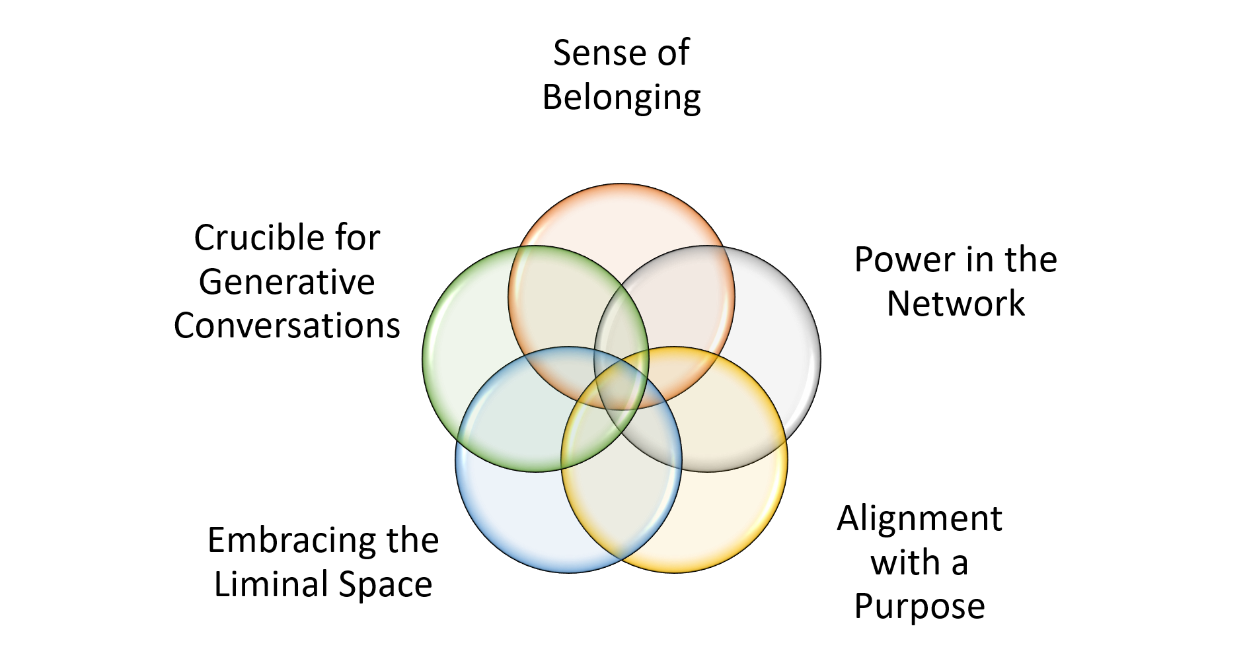
Sense of Belonging. Most often, most people, in most places are desperately trying to fit in — trying to be who they think they should be rather than who they truly are. We hardly ever feel a deep sense of belonging where we can show up in our authenticity and wholeness. There are parts of us we keep hidden knowing that they won’t be accepted. A sense of belonging doesn’t go hand-in-hand with the need to say the “right things”, to succumb to authority, with a loss of autonomy and agency, and a dread of showing up with our warts and all. True belonging comes from the freedom to be exactly who we are — confident and fearless in the knowledge of acceptance.
Communities that can create such safe spaces for everyone to show up authentically in all their uniqueness intact create the conditions for a multiplicity of voices and viewpoints to intertwine, synergize, and integrate. Such communities create the conditions for belonging characterized by invitation, inclusion, inspiration, insight, and interconnection. Only when people fully belong can they participate and contribute from their deepest and integral selves.
Amid this apocalypse, communities can provide us with solace, solidarity, and significance — a sense of being a part of something much larger than we can imagine even as we feel cut adrift from all our familiar moorings. And out of this cohesion, we gain the strength and endurance to hold space for our pain and dare to step into the future that is beckoning us — a future that must necessarily be completely different from our past. Therefore, purposefully formed communities exist at the intersection of individual agency and sovereignty while holding space for collective intelligence and sensemaking.
Power in the Network. A sense of belonging is closely aligned with “power.” We are familiar with “power over,” where some people have positional authority to wield power over others. The “others” are thus rendered powerless, robbing them of agency, sovereignty, and dignity. Dominance, coercion, and control are the keys to exerting power. Right now, most countries are experiencing some form of authoritarian and autocratic government where the latter is exercising power by controlling the resources we need to live — money, food, healthcare, livelihoods, etc., to the detriment and disadvantage of many.
A community has no place for “power over.” Here, the power lies in the spaces between people, in the networks, in the connections. It is shared power that grows out of collaboration and relationships. It is built on respect, mutual support, solidarity, influence, empowerment, and participatory actions. It hinges on the collective ability to act together for the common good. It is “power with” others — the power to collectively make a difference.
When an individual feels a deep sense of belonging and inner alignment with the community’s purpose, this translates into an experience of the “power to” make a difference. “Power to” is an inner sovereignty and agency that is felt as a movement within, an upsurge of one’s unique potential, a generative power emanating from the capacity to birth new possibilities and actions.
Sovereignty is the capacity to take responsibility. It is the ability to be present to the world and to respond to the world — rather than to be overwhelmed or merely reactive. Sovereignty is to be a conscious agent. …
Sovereignty is the center. If you are anchored in sovereignty and able to fully respond to the world, you are able to do the best you can do. ~Jordan Hall
Alignment with a Purpose. Our lives have, for the most part, shrunk to the four walls of our homes. As people shelter in place with lock-down still in effect in many parts of the world, it is easy to get lost in one’s own anxieties and fears. As our world narrows down to our homes, we run the risk of losing our sense of interconnection with the rest of humanity, and the web of life. Now is the time when we most need to come together. Not only as countries but as global citizens connected by a shared experience — perhaps for the first time in our lives.
It is human nature to want to be a part of something larger than oneself. That is the quest we are all a part of. When communities come together around a purpose that speaks to the soul, we know we have found our tribe. This feels empowering, providing meaning and anchor in a collapsing world. The pervasive uncertainty and ambiguity become bearable when we belong to a community, when we support each other in traversing this in-between space, when we are living into the questions that matter.
Embracing the Liminal Space. While as an individual, it can be overwhelming to immerse ourselves in uncertainty and stay in the in-between space, we can do this as a community. In fact, it is only as communities “exploring the intersection of the universal stories of human experience with the personal stories of our lives” can we make sense of what is happening. We can further enhance this by inquiry through multiple modes of reflection so that everyone can fine their own unique way of listening to their inner wisdom.
These can involve solitary practices like guided reflective journaling, creating vision boards, or group practices like sharing stories, music, movement, and any other art form. The idea is to listen to the subliminal voice within us, the inner source of wisdom that we suppress with our superficial cognitive prowess. When we allow this wisdom to rise to the surface, together we weave a “tapestry of truth” with many and diverse threads, creating a pattern that is inclusive, evolutionary, emergent. That includes and transcends the multitude of voices.
Staying in the liminal space asks us to be comfortable with and welcome silence. Silence can be truly generative; by not rushing to fill the silence, we create space for the universe to speak through us. Staying in silence is not a passive act but a conscious one of muting the inane mind-chatter, feeling the stillness within, and tuning into the field of resonance that is created. As we continue to explore, the possibilities latent in the liminal space emerge.
The liminal space is an invitation to surrender — an invitation to give over to something larger than self and trust that we will be held and supported with whatever we need in order to navigate the uncertainty. The degree to which we are comfortable or uncomfortable has to do with how we choose to be with what is happening. We can choose to fight against the liminal space and struggle, or to flow with it by listening, sensing, and responding. ~Alan Seale
Intentional communities help us to stay in this space between stories and navigate it together. That is when — by weaving together the kaleidoscope of narratives and perspectives — we can truly envisage a different world. I believe we are all agents of an interconnected whole, and communities are catalysts propelling us toward a regenerative future.
Crucible for Generative Conversations. This is perhaps the most important function and attribute of an intentional community — to hold space for generative conversations. I have often written about Otto Scharmer’s model of Generative Listening, the foundation of deep and authentic conversations. And I can’t repeat enough the importance of the 4th level of listening (depicted in the diagram below) in holding space for generative conversations:
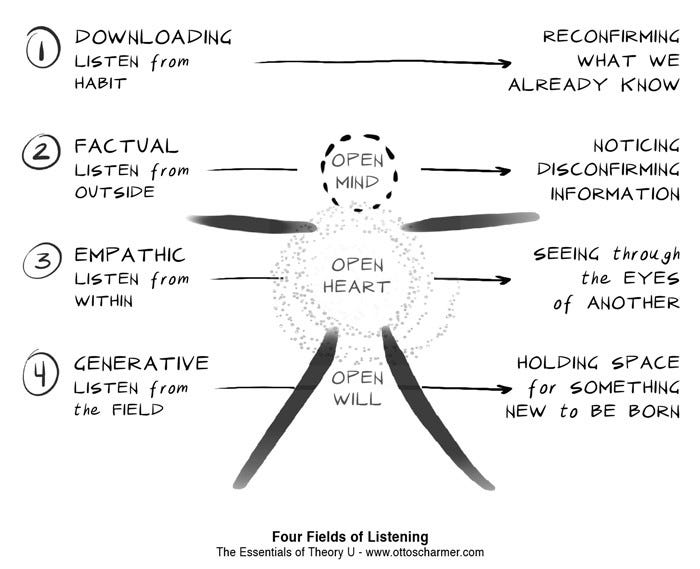
When communities become adept at facilitating “listening from the field,” they can literally listen the new into being. Real dialogue is a flow of meaning and purpose.
The Touchstones from Parker Palmer’s Circle of Trust process are also beautiful guidelines on creating an environment conducive to generative conversations.
o Give and receive welcome.
o Be present as fully as possible.
o What is offered in the circle is by invitation, not demand.
o Speak your truth in ways that respect other people’s truth.
o No fixing, saving, advising, or correcting.
o Learn to respond to others with honest, open questions.
Amid this chaos, how can we collectively hold space and sow the seeds of a different “way of being” on this planet?
Seeds of transformation lie in thoughtful, authentic, and vulnerable conversations. Every life-affirming and regenerative intention and interaction undertaken has far-reaching effect, percolates far beyond our imagination, and ultimately becomes a groundswell displacing the crumbling system.
Read part 1 HERE
Originally published HERE on June 5, 2020
Sahana Chattopadhyay is a global Speaker, Writer, Master Facilitator, Organization Development Consultant, and Coach. She works at the intersection of Complexity, Human Potential, Organizational Transformation, Systems Thinking, and Emergence. Her passion is to enable organizations to develop the capacities, skills, and mindsets to become “thrivable” in the face of uncertainty and ambiguity.
PLEASE DONATE to help Network Weaver continue in it’s mission to offer free support and resources to networks worldwide.
The Power of Communities in Uncertain Times — Part 1
When systems collapse, people rise…
A tiny, invisible, and obscure virus has thrown the world into chaos. It has flummoxed and baffled nations, countries, politicians, scientists, doctors, presidents, principals, parents, students, in short, everyone. The gears of the post-Industrial world have ground to a juddering halt for the first time in history. A great pause button has been pressed. What multiple calamities over the last decade couldn’t achieve has been done by an invisible virus.
Do we see this as Armageddon or a chance to re-imagine a “world that works for all”? Can we appreciate the grand design?
We are witnessing unfathomable and profound suffering, particularly of the marginalized and the deprived, in a world that was horribly unprepared for a global calamity of this nature. Many are likening this period to the 1918 Spanish Flu, which swept across the world killing between 17 million and 100 million people worldwide. We don’t yet know what the death toll of Covid19 will be as the virus rampages across nations made fragile by inequity, flouting all efforts to contain it. What to me seems sad and surprising is the abject failure of high tech, big data, and big pharma in coming up with anything remotely groundbreaking in the face of this apocalypse.
Yet, in the midst of it all, can we hold our fear and uncertainty with compassion? Can we abide in this in-between space and listen to its messages?
Unfortunately, while the situation calls for “collective coherence,” we are experiencing divisive and disruptive politics; segregation of humanity based on religion, race, caste, class, creed, and gender; acrimonious and hostile behavior toward the marginalized and the minorities almost everywhere. These unfolding patterns reveal and underscore the emotional and spiritual schisms, estrangement, and hollowness afflicting societies today. The pandemic, on the other hand, is emphasizing a lesson that is the exact opposite of this sense of separation; it is repeatedly accentuating the deeply intertwined and inter-related nature of all life on this planet.
Are we truly sensing and listening? Do we feel it in our bones that none of us can be happy, healthy, and healed unless all of us are?
Sadly, we have become attuned to the Story of Separation where each one must fend for themselves, defeat the “enemies,” demolish the weak. We are used to waging wars. We can bomb, blast, bulldoze, battle, and build walls to keep the enemy at bay. Unfortunately, the coronavirus does not yield to guns or grenades. Hence, while we seek to “wage a war” against the virus — the language most nations are using — we are failing. Sadly, it also says something about our world that we are more prepared for war than to deal with global health, hunger, and humanitarian crises. No wonder, many governments are trying to handle this like a war. It exonerates them for being singularly unprepared.
The narrative of war is used as a legitimizing discourse. Wars inevitably have casualties. Wars require sacrifice. The narrative of war heroes is used to justify putting health workers at risk.
Not only is the analogy of war misplaced on factual grounds; it also misses the possibility to cultivate an imagination that builds on narratives of peace, solidarity and social justice — and to foster a more acute understanding of how we are all fundamentally dependent on one another as inhabitants of a shared planet.
How would a resilient, responsive, and anti-fragile world have responded to the crisis? What can we collectively do to co-create such a world?
What is becoming evident is that in the face of this apocalypse, it is not high tech and military prowess but high touch and compassion that is saving the day — doctors, nurses, healthcare workers, grocery storekeepers, teachers, journalists, civilians, NGOs. Communities of citizens are coming together to distribute food to the hungry, make masks for hospitals, help stranded migrant workers in India reach home, and much more.
I wonder, when we come out of this crisis, how will our priorities change? How will we honor what truly makes us human? What choices will we make as individuals and collectives to envision and reinvent a resilient and regenerative future?
For a long time, the world has been teetering on the brink of collapse, and now Covid19 has pitched us headfirst into the center of it. The fissures and fractures in our societies and nations, the rifts and ruptures in our politics and policies, and the crudely papered-over sordid and squalid brokenness of the systems stand brutally exposed. We suddenly find ourselves floundering in a liminal space of uncertainty, ambiguity, and unknowing. Lost and adrift emotionally, spiritually, and even physically, we are scrambling to make sense of a world that has fallen apart, whose center proved too weak to hold and sustain. And as the center collapses, we can see the edges rising.
Are we noticing the rise of ordinary citizens? What will it take for this sense of inter-connectedness to persist even after the crisis is past? How can we continue to act from this place of Interbeing?
Despite the superficial gloss and glitz of the 21st century life, we have failed to build resilient societies. We have collectively made choices over decades that have brought us to this point in our civilization’s trajectory. We have ignored signs and warnings of ecological crisis, social turmoil, and political perfidy. We have long forgotten that we are inextricably and indelibly connected to all human and more-than-human life on this planet. I believe that Covid19 is giving us an opening to pause, reflect, and re-imagine a different world — a world of greater equity, justice, well-being, and security for all sentient beings.
What does a more integrated, thrivable, and regenerative world look like? How do we align with our inner source of being? How do we befriend our future emergent selves?
It is asking us to go beyond our current selves, befriend our emergent selves, and co-create a more beautiful world from this liminal space that we are currently in. Perhaps no other writer or poet has captured the essence of it like David Whyte…
Just Beyond Yourself
Just beyond
yourself.It’s where
you need
to be.Half a step
into
self-forgetting
and the rest
restored
by what
you’ll meet.
I see hope arising even in the midst of anxiety and anguish. Our forgotten humanity — submerged in the false busyness of our days — is rising to the surface. I am seeing myriad groups of individuals going beyond their selves and coming together to serve the desperate and the deprived even as governments, strategists, and policy-makers flounder and resort to denial, de-sensing, and destroying every little possibility out of avarice, dishonesty, and egotism. But the “movement of movements” is refusing to be subdued. As Otto Scharmer rightly said, As Systems Collapse, People Rise.
How can we come together as evolutionary communities to heal the planet? How can we bring our gifts in service of a regenerative future?
Paul Hawken described this “movement of movements” beautifully…
I believe that we are part of a movement that is greater, and deeper,
and broader than we ourselves know, or can know.
It flies under the radar of the media, by and large.
It is non-violent. It is grassroots.
It has no cluster bars, no armies and no helicopters.
It has no central ideology.
A male vertebrate is not in charge.
And it is this power of communities that I want to write about. I have been urging organizations to reinvent themselves as communities and ecosystems in my articles, some of which can be found here, here, and here. I believe that the power of communities — people coming together around a shared vision, passion, and purpose — can transform the world and take us toward an anti-fragile, resilient, and regenerative future.
How can communities of diverse and committed individuals reinvent and co-create the metaphors, narratives, and structures for a thrivable future?
“There is no power for change greater than a community discovering what it cares about.” — Margaret J. Wheatley
Let me digress a bit and explain what I mean by “communities.” It is NOT an echo-chamber where homophily — a fancy word for group think — is the norm. Echo-chambers are designed around the concept of “Us” vs “Them” — a constant “othering” that keeps the world polarized, divided, angst-ridden, and adversary-filled. We can see this everywhere with human beings turning against fellow humans on the grounds of caste, class, creed, religion, race, sex, age, food habits, and every other criterion we can imagine. Social media — once the dream of democratic communication and the fount of collective intelligence — have had exactly the opposite effect. It has exacerbated polarization, group-think, and schism under the guise of globally interconnected networks.
Instead of celebrating the vibrant, joyous, and abundant diversity that makes up our world, we are striving to create a monochrome palette that will render our planet dreary, dull, and dangerous. Our very regeneration and resilience lie in diversity and difference. This is where, I believe, consciously designed communities come in. Communities come into being when diverse individuals come together in the service of a purpose larger than themselves. A purpose that feels aligned with their own calling and invites all on a co-creative journey that moves them toward the purpose.
As the old world falls apart, what is emerging are networks of individuals stepping forward to take care of the brokenness, to heal the wounds with whatever resources are available to them, to step beyond the self into a larger space of oneness. They are as diverse as they come and yet they are bound together by a vision of a fairer, just, and a kind and compassionate world. Most of these communities have formed spontaneously in response to the appalling predicaments and miseries being faced by the dispossessed everywhere.
Such communities are built on voluntary participation based on inner alignment and coherence of purpose. They foster a deep sense of belonging, where everyone contributes from their sense of selfhood and unique capabilities. Such synergy cannot be forced but arises from an intermingling of varied perceptions; thus, the whole is always greater than the sum of the parts. Something is born that didn’t exist before. The intangible is expressed, the unthought is revealed, the elusive becomes explicit. The impossible gets done. And a “new way of being” is birthed. Hope refuses to die. New metaphors, narratives, and structures are co-created. Such is the power of intentional communities.
As the world teeters on the brink, we need such compassionate communities to be compasses that can guide us toward a future different from our past, that can become the “imaginal cells” of a more beautiful world our hearts know is possible.
May the best among us, the most visionary, the most inclusive, be the imaginal cells — for now we are in the soup. The outcome of disasters is not foreordained. It’s a conflict, one that takes place while things that were frozen, solid and locked up have become open and fluid — full of both the best and worst possibilities. We are both becalmed and in a state of profound change.
I have explored the qualities and prerequisites of such intentional and conscious communities in Part 2 of this post.
*The tagline of this post is inspired by Otto Scharmer’s article of the same name.
Read part 2 HERE
Originally published HERE on June 1, 2020
Sahana Chattopadhyay is a global Speaker, Writer, Master Facilitator, Organization Development Consultant, and Coach. She works at the intersection of Complexity, Human Potential, Organizational Transformation, Systems Thinking, and Emergence. Her passion is to enable organizations to develop the capacities, skills, and mindsets to become “thrivable” in the face of uncertainty and ambiguity.
PLEASE DONATE to help Network Weaver continue in it’s mission to offer free support and resources to networks worldwide.
How learning ecosystems evolve and how can leaders weave the whole change process
Weaving educational ecosystems in our districts and cities has become one of the greatest worldwide challenges for our systems to enhance learning and equity for the new era. The UNESCO (2020) publication “Education in a Post-COVID World: Nine Ideas for Public Action” indicates that those communities that have responded in an innovative, effective and resilient way to the crisis of COVID-19 are those who had shown greater collaboration between teachers, and between school and community actors. These ideas are also shown by other recent studies on school networks by Daly (2020) Azorín (2020) and Ion & Brown (2020). The reality of this pandemic has reminded us as a species that we are deeply connected to one another (Lancet 2020).
Learning ecosystems are social infrastructure formed by diverse actors that share a purpose, and engage in collaboration to co-design and co-implement innovative responses to existing social and educational challenges. Learning ecosystems provide a new understanding of education from an ecosystemic perspective of actors and their relationships; they challenge traditional organizational boundaries while providing place-based focus on local schools, neighborhoods, cities, or transnational networks; they are based on systemic and cross-sectorial collaboration; and pursue systemic impact (Díaz-Gibson et al., 2020). Thus, one of the most relevant questions in the global educational sphere is how learning ecosystems can be intentionally supported, cultivated and weaved, and how these place based ecosystems grow and evolve over time.
A natural way to approach and better understand learning ecosystems’ development and growth process is to dig into how biological ecosystems change and evolve. Science shows us that collaboration between organisms and species, not struggle for survival that allows ecosystems to evolve and species to truly flourish. As Darwin defended, if humans are the most advanced species it’s because we have the most advanced means of collaborating, and our communities care for the most vulnerable, the sick, the elderly and impoverished. Thus, collaboration is actually a natural and social driver for species survival and for thriving communities.
Ecosystems evolution is drawn byecological succession, understood as the process of change in the species structure of an ecological community over time, where a network of different populations and organisms coexist and interact. The time scale for a biological ecosystem to evolve can be decades -for example, after a wildfire-, or even millions of years. The community begins with relatively few pioneering plants and animals and develops through increasing complexity until it becomes stable or self-perpetuating as a climax community. The engine of succession becomes the impact of established organisms upon their own environments. In other words, intraction among species and within the environment are the drivers of change in all ecosystems.
Colleagues in the NetEduProject have been studying networks, partnerships and ecosystems that enhance learning and equity in the last two decades (Daly, 2010; Riera and Civís, 2008; Díaz-Gibson, 2014; Díaz-Gibson et al, 2017 and 2020). Our learnings show that the development of learning ecosystems and their relational networks become a taugh and complex process that needs time and efforts to be properly cultivated, weaved, and consolidated. Personal relationships require time and intention to emerge and sustain, and their growth involves devoting intentional efforts. With this in mind, Mireia Civís and I have worked on a model to cultivate and weave learning ecosystems in three non linear steps, where we identified some patterns of evolution. Thus, to weave learning ecosystems we need to focus on different conditions depending on its level of maturity:
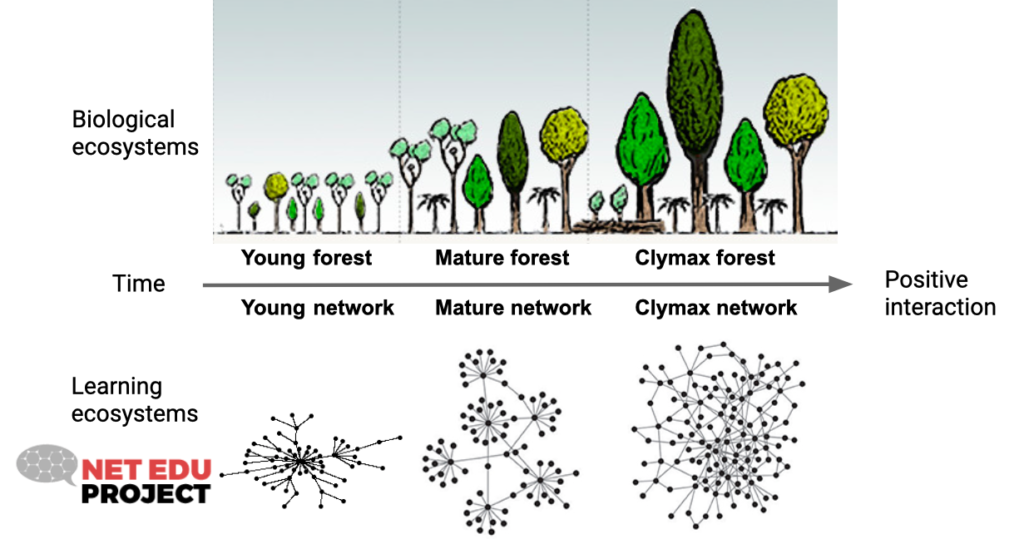
- The initial stage of the ecosystem’s growth is shown in the image as ‘Young network’. Following the idea of ecological succession, ecosystems change depends on the initial conditions found in the social network, and the type and number of actors, and the quantity and quality of relationships draw an initial starting point. At this stage, it is necessary to develop a structural design to cultivate the social foundations that will sustain the whole ecosystem: trust, empathy, recognition of others and collective purpose. It is the moment where members share goals and expectations, adjust rhythms and levels as new relationships are woven. This social capital will sustain the future development of the whole ecosystem of people and organizations, and will become the pillars that pave the way for a new collaborative culture. At this point, collective learning is a priority flow that needs to be planned, at the same time, will be part of the network’s own working culture. Ecosystems can take from one to three years to move into a second stage, and only the construction of solid intangible pillars will allow networks to change and evolve.
- The second stage, named as ‘Mature network’, is more difficult to limit in time as its duration depends on several factors beyond the initial network conditions, such as investment, political support or system coherence. Here, we need to move towards the development and sustainability of social networks, and one of the aims is to consolidate the transition from individual to institutional commitment. It becomes a stage where we want to sustain a collaborative model of action and where we must continue to feed the social intangibles generated. At the same time, new strategies are being sought to assess and increase the impact of collective action. Once networks are weaved, they must come to live and make sense for themselves, they may not depend (or only depend) on external leadership. Also, at this point they must generate clear benefits for their participants according to the established objectives. The design and the structures need to be flexible and readjust to optimize resources to respond to needs and expectations of the people and organizations involved, also drawing clarity on paths for local based outcomes to emerge.
- Finally, the third stage named as ‘Climax network’, is also imprecise in time for the same reasons. In this stage, the ecosystem creates intentional infrastructures for its sustainability beyond personal relationships, establishing institutional agreements, coordination documents, new opportunities for participation, among others. These strategies are aimed to facilitate interaction and self governed initiatives within the network. Here the ecosystem acquires an optimal level of maturity that is evidenced by consolidation of a new culture, where new rules and new ways of doing are practiced in professional and institutional levels. The network organization within the ecosystem in this stage tends to be characterized by a collaborative governance. People are empowered to open new cycles of revision and regeneration in order to create new meaning and new opportunities for individuals and for the collective.
We believe these three fluid and organic steps can inform the type of systemic support needed in the evolution of ecosystems to enhance social capital, learning and equity in our communities and cities across the globe. In the NetEduProject we are ‘hands on’ working on learning and sharing new leadership strategies that can move these social and participatory structures forward over time. As shared in the beginning of this post, science has shown that collaboration is a natural driver for species survival. In this new era we are all embracing, humans and social systems really need to improve our collaborative competences to better take care of one another and create a thriving world for all.
originally published at NET EDU PROJECT
I am a 24-hour learner, passionate collaborator and weaver. Interested in weaving between contexts, disciplines, research and practice to enhance collective impact. I believe that education is a tremendous weapon to change the world.
PLEASE DONATE to help Network Weaver continue in it’s mission to offer free support and resources to networks worldwide.
Collective Mind Community Conversations
The impact of the pandemic on networks: Learning from network managers’ experiences
Collective Mind hosts regular Community Conversations with our global learning community. These sessions create space for network professionals to connect, share experiences, and cultivate solutions to common problems experienced by networks. In November 2020, Collective Mind hosted a special series of our regular Community Conversations to learn from one another’s experiences of managing networks during the Covid pandemic.
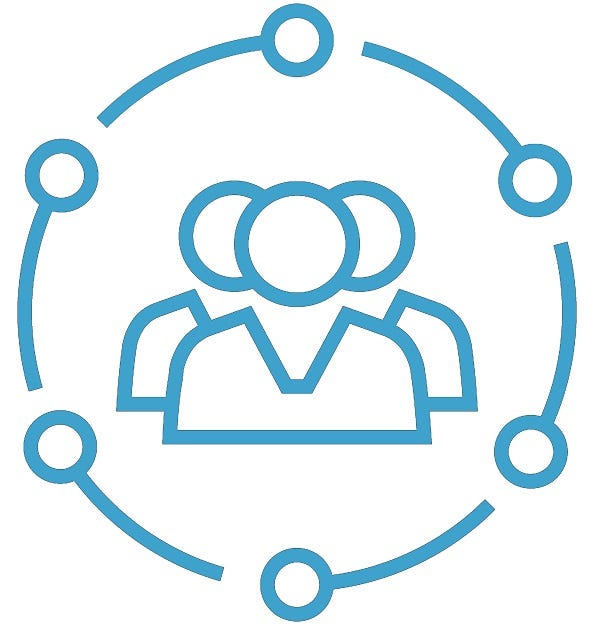
The proverbial wrench that the Covid pandemic has thrown at us all cannot be understated. We’ve had to adapt our lives, work, and workplaces in unanticipated ways while long-term questions continue to linger. For networks and their staff, the impact of the pandemic has raised unique challenges for an already challenging field of practice.
Networks — a catch-all phrase for various types of collective organizing models — function by coordinating members to actively co-create value, community, and impact toward achieving a shared purpose. Behind networks that work in climate change, education, philanthropy, and everything in between, network staff work diligently in service to and in support of their members to accomplish collective goals. In the best of times, network staff wear many hats on behalf of their members: administrator, facilitator, technical expert, cheerleader, counselor, connector, coordinator, wrangler, problem-solver, communications liaison, and more. But in the midst of an enduring global pandemic, new struggles have emerged and old struggles have become amplified.
While many real and threatening struggles persist, the pandemic has also been an opportunity for networks to learn, reflect, and evolve. Eight months in, necessity has led to innovation and the initial experience of shock and uncertainty has transformed into new practices and mindsets. These lessons, insights, and tips from a diverse, global audience of network practitioners give us hope and remind us of the power of networks.
What are networks experiencing in this pandemic, and what can we learn from network managers who have weathered this year?
Building new relationships and partnerships in a pandemic can be challenging — but the pandemic is also an opportunity for more intentional collaborations. The dearth of in-person interactions has made it more difficult to create organic connections, both among network members and with potential outside partners. In-person gatherings offer us chances to meet, engage, and collaborate with colleagues and new contacts in a way that Zoom meetings struggle to recreate. Networks often rely on the spontaneous, serendipitous connections made face-to-face as both a key benefit of being part of the network and as fuel for network engagement. Without in-person spaces, building relationships has felt stilted.
At the same time, moving most of our lives online has opened doors for accessing and discovering new people and creating value together in different ways. Relying on social media and virtual outlets to connect us has become a sort of equalizer, as has the humbling experience of letting the world into our homes through a computer camera. And instead of passive exchanges with many, we’re investing our energy more selectively. As a result, network managers have been forging action-oriented connections with more tangible goals and outcomes. They’re asking important questions such as, what could be mutually beneficial about this relationship? How can we uplift each other, share platforms, and open doors together? What is worthy of everyone’s time? The result is intentional partnerships, anchored in and driven by action and shared value — much like the impetus of a network. Within networks, staff have had to make network weaving more explicit. It can take effort to create virtual collaboration spaces, manage new means of member engagement, or step in to build links and bridge connections. But creating more diverse outlets and on-ramps for connection may also have been overdue (more on this below).
Networks can struggle to stay relevant as members retreat into their own organizations — but there has also been an opportunity to engage members differently and make creative pivots to meet the new operating environment. The upheaval of the pandemic rapidly created unknowns for organizations around funding, staff, programmatic viability, and more that, for many, shifted their focus inward and away from outside commitments. Fostering a network mindset among a membership is already a constant effort but the pandemic created new uncertainties for networks about how to stay relevant to their members, how to fulfill network obligations when participation is unpredictable, and how to maintain engagement without the same ability to bring expected value and benefits to members as before. The pandemic has also affected the missions and activities of some networks, forcing a shift in priorities to meet new demands and address pandemic-related fallout.
In this new landscape, networks understand that they cannot rest on their laurels. Staying relevant and effective requires shaking up norms and embracing new possibilities. Faced with member disengagement, network staff have reimagined opportunities for new kinds of engagement. Listening to members and seeking to understand their needs has been critical for networks to adapt, be responsive, and maintain value. Where possible, staff have gone out of their way to get to know more network members personally and learn directly from them about what an updated value proposition for the network could be. While opening up new avenues for engagement, networks have also embraced the reality of what can get done and how, choosing to postpone or adjust certain network activities.
By centering members in the process of adapting, networks have identified and created paths for leaders to emerge in new ways. They’ve been able to lean into those who have stayed at the table and empower engaged members as network weavers. Leveraging expertise from across the network — like facilitating new groups or sharing skills — has generated new kinds of leadership, and tailoring content for subgroups around their specific interests has helped keep members’ attention. Network staff have had to expand their skillsets and stretch their job descriptions for the sake of stewarding the network. But embracing emergence and relying on members to help shape the network has served to reinforce the origins and intent of a collaborative networks practice.
While we lean on new technology more than ever before, no one tech platform seems to be a silver bullet (yet) — and this may be the lesson we needed all along. For many networks, virtual engagement and collaboration had begun trending long before the pandemic. For others, upgrading technology and transitioning to online platforms was not seen as a priority. Regardless of experience, the pandemic quickly required network staff to become savvy technical administrators and, most importantly, amplified the crises of tech barriers, inequality, and gaps in internet access and stability. Network memberships with older demographics, limited tech experience, and gaps in digital fluency have struggled. Across the board, the impact of relying on tech for participation and the implications for member inclusion and equitability have been significant challenges.
In truth, many of these issues were not new to the pandemic. Social and infrastructure disparities have always persisted (especially between global memberships and Western-led secretariats), and effective technology has been a moving target for years. A meaningful pivot toward embracing tech and finding solutions for inclusion has been a long time coming, and in this way, the pandemic has pushed us forward.
Networks have skilled up and committed to finding solutions to virtual connection, experimenting with a huge range of platforms. They’ve often found that using what people know wins out and that the path of least resistance cannot be underrated. Practitioners emphasize that it’s critical to know and center your audience: some memberships have the skills and bandwidth to use flashy tech platforms, while others will need to use what they know and can access, like Facebook and email. The key is to use what works for your network and build on it, and to accept the inevitability that it may take multiple platforms and channels to address different learning styles and communication preferences. While new platforms can feel annoying or daunting for members, practitioners have found that steadily integrating them as go-to resources, and even giving tutorials or extra guidance, can create new habits and foster successful adoption of new technology. And in the spirit of networks practice, many network managers have also learned to fight the urge to be a gatekeeper to virtual connections or to force uptake of new tools for online collaboration. Staff must often lay the groundwork, but networks flourish by observing and learning from members’ behaviors while allowing for emergence.
The pandemic has tested us — but it has also allowed for personal strengths to evolve and shine. Managing networks effectively involves hard and soft skills, like listening, facilitation, organization, and flexibility. The need to hold space for members during a pandemic has pushed network practitioners to flex these personal attributes, cultivate new skills, and learn about themselves in new ways. Many shared that they have learned to sit with uncertainty — to be resilient and agile, to accept that we might not know what’s going to happen next, and to embrace what comes. Centering practices such as learning, listening, and balance has become essential in work and in life. They’ve also learned to reject rigidity and perfection, and to allow for emergence within the network and in what demands and opportunities come to staff. Ultimately, network managers have been focused on relationships: investing in them, building them, stewarding them, and celebrating them. Relationships anchor networks and relationship management is a core and common skill of network managers. These network management skills are a constant practice, and in these challenging times, practitioners have certainly risen to the occasion.
Collective Mind seeks to build the efficiency, effectiveness, and impact of networks and the people who work for and with them. We believe that the way to solve the world’s most complex problems is through collective action – and that networks, in the ways that they organize people and organizations around a shared purpose, are the fit-for-purpose organizational model to harness resources, views, strengths, and assets to achieve that shared purpose.
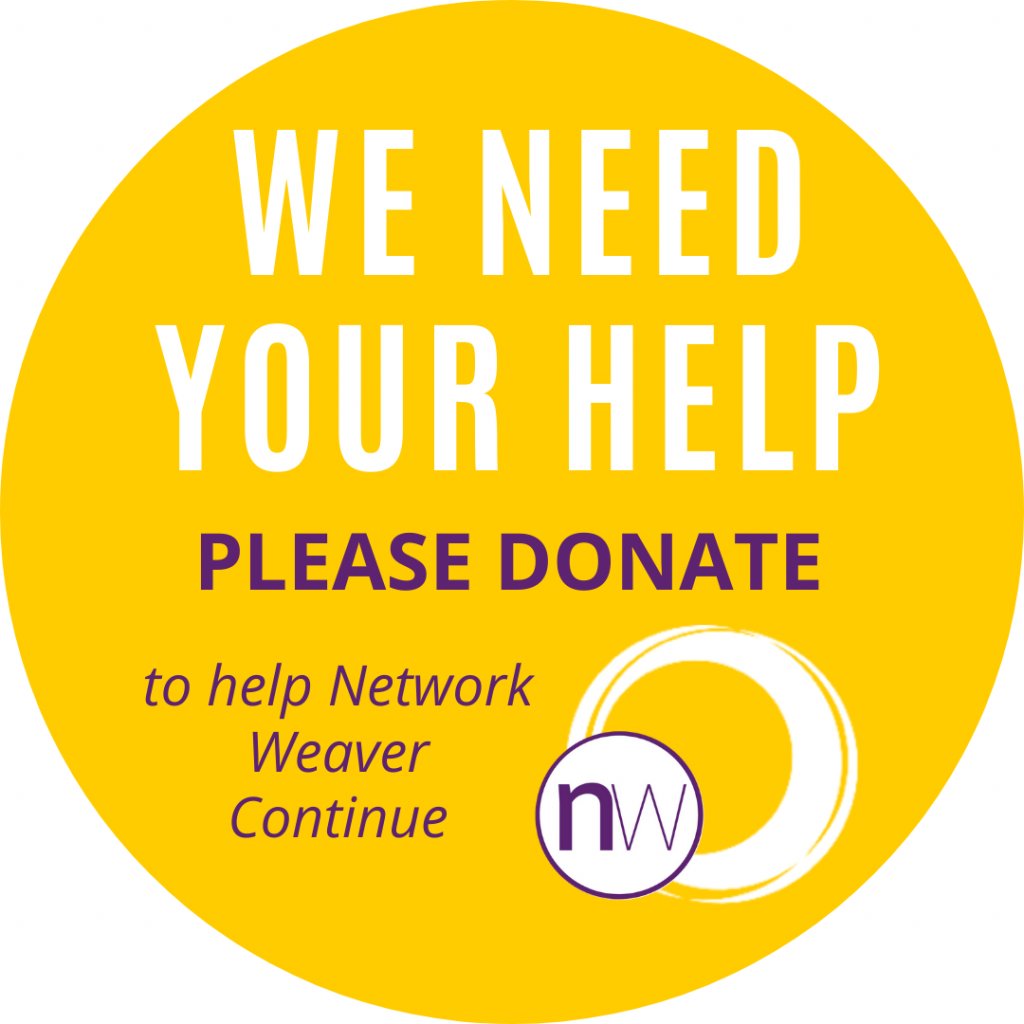
Originally published on Medium / Collective Mind





